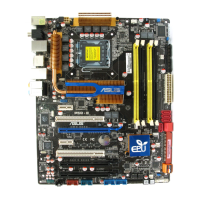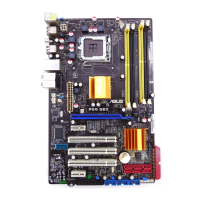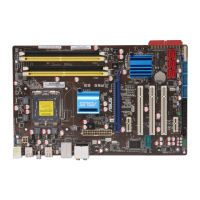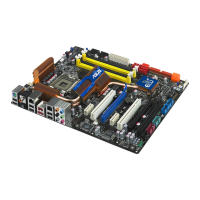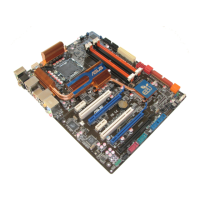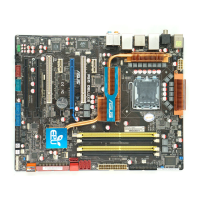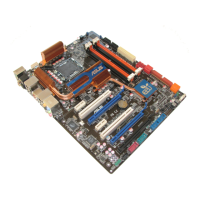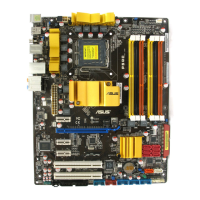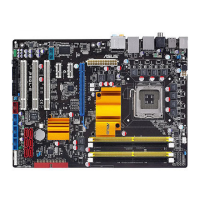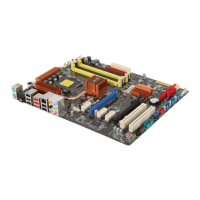Do you have a question about the Asus P5QL and is the answer not in the manual?
Welcomes the user to the ASUS P5QL motherboard and its features.
Lists the items included in the motherboard package for the user to check.
Highlights the key features and technologies of the ASUS P5QL motherboard.
Provides essential precautions and steps before installing motherboard components or settings.
Details the physical layout and components of the motherboard for installation.
Covers the installation and related components for the CPU on the motherboard.
Explains the system memory (DIMM) sockets and configurations for installation.
Describes the different expansion slots available on the motherboard for add-on cards.
Explains the function and configuration of various jumpers on the motherboard.
Details the various internal and external connectors on the motherboard.
Guides on how to manage, save, and update the motherboard's BIOS.
Explains how to access and navigate the BIOS setup utility for system configuration.
Describes the basic system information displayed in the Main menu of the BIOS setup.
Details settings for configuring system performance and overclocking options.
Covers advanced settings for CPU, chipset, and other system devices.
Explains advanced power management (APM) settings for system control.
Guides on configuring system boot options and device priority.
Lists utilities and special functions accessible through the BIOS Tools menu.
Describes options for saving, discarding, or loading BIOS settings.
Outlines FCC compliance and operational conditions for the device.
Details compliance with Canadian radio noise emission regulations.
Advises on proper disposal of the motherboard and battery to protect the environment.
Provides critical safety precautions related to electrical hazards during handling and installation.
Outlines essential safety measures for operating and handling the motherboard.
Explains the structure and content of the user guide for better navigation.
Directs users to the ASUS website for updated product and software information.
Mentions optional documentation that may be included with the product package.
Explains symbols indicating information to prevent injury to yourself.
Explains symbols indicating information to prevent damage to components.
Explains symbols indicating instructions that MUST be followed.
Explains symbols indicating tips and additional information.
Defines formatting conventions like bold, italics, and key notations used in the manual.
Details the CPU socket type and compatible Intel processors for the motherboard.
Lists the Intel chipset used and its associated technologies.
Specifies the supported system bus frequencies for the motherboard.
Describes the memory architecture, type, and maximum capacity supported.
Lists the types and number of expansion slots (PCIe, PCI) available.
Details the storage interfaces supported, including SATA and PATA.
Specifies the LAN controller and its features.
Describes the onboard audio codec and its capabilities.
Lists the number of USB ports available on the motherboard.
Enumerate the BIOS firmware features and utilities supported.
Highlights proprietary ASUS technologies and solutions for enhanced functionality.
Details advanced tools for CPU overclocking, voltage, and frequency tuning.
Lists additional features not covered in specific categories.
Describes the connectors and ports available on the motherboard's rear panel.
Lists the internal headers and connectors for system components.
Covers management features like WOL, WOR, and PXE.
Lists the accessories typically included with the motherboard package.
Lists the contents of the support DVD, including drivers and utilities.
Specifies the physical dimensions and form factor of the motherboard.
Welcomes the user to the ASUS P5QL motherboard and its features.
Lists the items included in the motherboard package for the user to check.
Highlights the key features and technologies of the ASUS P5QL motherboard.
Provides essential precautions and steps before installing motherboard components or settings.
Details the physical layout and components of the motherboard for installation.
Covers the installation and related components for the CPU on the motherboard.
Explains the system memory (DIMM) sockets and configurations for installation.
Describes the different expansion slots available on the motherboard for add-on cards.
Explains the function and configuration of various jumpers on the motherboard.
Details the various internal and external connectors on the motherboard.
Guides on how to manage, save, and update the motherboard's BIOS.
Explains how to access and navigate the BIOS setup utility for system configuration.
Describes the basic system information displayed in the Main menu of the BIOS setup.
Details settings for configuring system performance and overclocking options.
Covers advanced settings for CPU, chipset, and other system devices.
Explains advanced power management (APM) settings for system control.
Guides on configuring system boot options and device priority.
Lists utilities and special functions accessible through the BIOS Tools menu.
Describes options for saving, discarding, or loading BIOS settings.
Outlines FCC compliance and operational conditions for the device.
Details compliance with Canadian radio noise emission regulations.
Advises on proper disposal of the motherboard and battery to protect the environment.
Provides critical safety precautions related to electrical hazards during handling and installation.
Outlines essential safety measures for operating and handling the motherboard.
Explains the structure and content of the user guide for better navigation.
Directs users to the ASUS website for updated product and software information.
Mentions optional documentation that may be included with the product package.
Explains symbols indicating information to prevent injury to yourself.
Explains symbols indicating information to prevent damage to components.
Explains symbols indicating instructions that MUST be followed.
Explains symbols indicating tips and additional information.
Defines formatting conventions like bold, italics, and key notations used in the manual.
Details the CPU socket type and compatible Intel processors for the motherboard.
Lists the Intel chipset used and its associated technologies.
Specifies the supported system bus frequencies for the motherboard.
Describes the memory architecture, type, and maximum capacity supported.
Lists the types and number of expansion slots (PCIe, PCI) available.
Details the storage interfaces supported, including SATA and PATA.
Specifies the LAN controller and its features.
Describes the onboard audio codec and its capabilities.
Lists the number of USB ports available on the motherboard.
Enumerate the BIOS firmware features and utilities supported.
Highlights proprietary ASUS technologies and solutions for enhanced functionality.
Details advanced tools for CPU overclocking, voltage, and frequency tuning.
Lists additional features not covered in specific categories.
Describes the connectors and ports available on the motherboard's rear panel.
Lists the internal headers and connectors for system components.
Covers management features like WOL, WOR, and PXE.
Lists the accessories typically included with the motherboard package.
Lists the contents of the support DVD, including drivers and utilities.
Specifies the physical dimensions and form factor of the motherboard.
| Non-ECC | Yes |
|---|---|
| Number of memory slots | 4 |
| Maximum internal memory | 16 GB |
| Processor socket | LGA 775 (Socket T) |
| Processor manufacturer | Intel |
| USB 2.0 connectors | 3 |
| Number of COM connectors | 1 |
| Number of SATA connectors | 6 |
| PS/2 ports quantity | 2 |
| USB 2.0 ports quantity | USB 2.0 ports have a data transmission speed of 480 Mbps, and are backwards compatible with USB 1.1 ports. You can connect all kinds of peripheral devices to them. |
| Firewire (IEEE 1394) ports | 0 |
| Audio chip | VIA VT1708S |
| Audio output channels | 7.1 channels |
| Motherboard form factor | ATX |
| BIOS type | AMI |
| BIOS memory size | 64 Mbit |
| Networking features | Gigabit LAN |
| Depth | 193 mm |
|---|---|
| Width | 305 mm |
